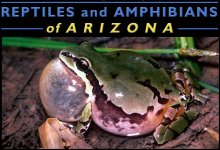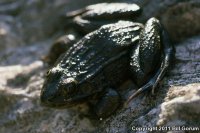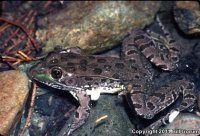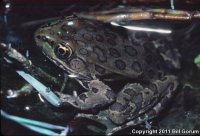| Range: |
 |
| Other Names: |
|
| Description: |
This leopard frog grows to about 4.3 inches in length, and is a green or brown frog with dorsolateral folds and numerous, relatively small dark spots. Frogs are often green, or have green on the head. The Chiricahua leopard frog is distinguished from other leopard frogs by a combination of characters, including a distinctive salt and pepper pattern on the rear of the thigh of adults and some juveniles, dorsolateral folds that are interrupted and inset towards the rear; stocky body proportions; eyes that are relatively high and upturned on the head; and relatively rough skin on the back and sides. Compared to other leopard frogs, the tadpoles are relatively dark, mottled, and stocky. Tadpoles grow to > 3 inches. |
| Similar Species: |
The most distinctive of the Leopard Frogs in New Mexico. It is unique in having prominent white spots on a dark ground color on the tuberculate posterior surface of the thigh. It can be distinguished from the Lowland Leopard Frog by the presence of spots on the nose anterior to the eyes, its distinctive thigh pattern, green coloration on the dorsum and the presence of vestigal oviducts in males. |
| Habitat: |
Historically it occurred in a variety of wetland habitats, but is now restricted primarily to stock tanks and other man-made waters, as well as headwater streams, cienegas, and springs that lack introduced predators. Breeds in deeper pools and relatively calm water. |
| Behavior: |
Can be found active day or night, although they are easier to find and observe at night with a headlamp or flashlight. |
| Hibernation: |
|
| Reproduction: |
Breeds primarily from April through October, but egg masses are unusual in June. Populations >5,900 ft breed June-August. Spherical egg masses of up to 1,485 eggs are laid in quiet pools, typically attached to vegetation. Tadpoles take 3-9 months to metamorphose, and some overwinter. Adult males give a distinctive advertisement call consisting of a relatively long snore of 1 to 2 seconds in duration. |
| Diet: |
The Chiricahua leopard frog presumably feeds upon a wide variety of invertebrates as well as some small vertebrates (including juveniles of their own kind). |
Adapted from account on reptilesofaz.org
Sources:


|













